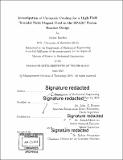| dc.contributor.advisor | John. G. Brisson and Joseph Minervini. | en_US |
| dc.contributor.author | Barber, Julien (Julien Victor) | en_US |
| dc.contributor.other | Massachusetts Institute of Technology. Department of Mechanical Engineering. | en_US |
| dc.date.accessioned | 2018-10-22T18:47:06Z | |
| dc.date.available | 2018-10-22T18:47:06Z | |
| dc.date.copyright | 2018 | en_US |
| dc.date.issued | 2018 | en_US |
| dc.identifier.uri | http://hdl.handle.net/1721.1/118738 | |
| dc.description | Thesis: S.M., Massachusetts Institute of Technology, Department of Mechanical Engineering, 2018. | en_US |
| dc.description | Cataloged from PDF version of thesis. | en_US |
| dc.description | Includes bibliographical references (pages 111-114). | en_US |
| dc.description.abstract | Rare Earth Barium Copper Oxide (REBCO) High Temperature Superconducting (HTS) tapes are being considered for the Toroidal Field (TF) magnets of the highly compact, high-field SPARC Version 0 (V0) reactor design. The V0 design is set to operate at magnetic fields as high as 20 T, and operating temperatures ranging from 10-30 K. Due to the increase in range of operating conditions made available through the HTS-based magnets, a new set of cryogenic fluids are being considered for forced flow cooling. This thesis analyzes the thermophysical properties of helium, hydrogen, and neon, and constructs a numerical model to investigate the forced flow cooling for REBCO HTS tapes under the extreme heating conditions present in the SPARC V0 design. Four design criteria are used to assess each cryogen, including the current sharing temperature, fluid inlet temperature, cable pressure drop ([delta]P), and operating pressure. From the results of the model, neon is removed from consideration due to its high required pressure drop and low temperature margins imposed by the superconductor current sharing limit. Hydrogen provides the highest effective heat transfer rate operating at inlet conditions of 1.5 MPa and 15 K, but is constrained by safety considerations. Helium is also able to meet the current sharing condition, but with higher initial pressure and lower initial temperature. Using the numerical model, an analysis using the four design criteria finds an optimal operating condition for helium of 2.5 MPa and 10 K based on minimizing cable pressure drop ([delta]P) and inlet pressure, while maximizing the fluid's inlet temperature. With a target operating point defined, an experimental cryogenic flow loop is designed with the purpose of verifying the high heat transfer rates required for the high-pressure, supercritical helium flow in the SPARC reactor. The flow loop uses a pressure differential to drive flow at a target mass flow rate of 46 g/s. To simulate a plasma pulse, the fluid flow is subject to heat fluxes up to 45 kW/m² for a minimum duration of ten seconds. | en_US |
| dc.description.sponsorship | Supported by the U.S. Department of Energy, Office of Fusion Energy Science Grant: DE-FC02-93ER54186 | en_US |
| dc.description.statementofresponsibility | by Julien Barber. | en_US |
| dc.format.extent | 114 pages | en_US |
| dc.language.iso | eng | en_US |
| dc.publisher | Massachusetts Institute of Technology | en_US |
| dc.rights | MIT theses are protected by copyright. They may be viewed, downloaded, or printed from this source but further reproduction or distribution in any format is prohibited without written permission. | en_US |
| dc.rights.uri | http://dspace.mit.edu/handle/1721.1/7582 | en_US |
| dc.subject | Mechanical Engineering. | en_US |
| dc.title | Investigation of cryogenic cooling for a high-field toroidal field magnet used in the SPARC fusion reactor design | en_US |
| dc.type | Thesis | en_US |
| dc.description.degree | S.M. | en_US |
| dc.contributor.department | Massachusetts Institute of Technology. Department of Mechanical Engineering | |
| dc.identifier.oclc | 1057284846 | en_US |
